Main content starts here.
Kyoto Brand Goods
Description:
Kyoto Prefecture’s agricultural, forestry, and marine products, fostered by Kyoto’s long history and tradition, are the heart of Kyoto’s food culture. Products carefully selected for their exceptional quality are certified as Kyoto Brand Goods and are sold with the “Kyo Mark.”
Kyo-Yasai Brand
Marine Product Brand
Processed Goods Brand
Individual vegetables are described on the attached sheets.
Distribution and Brand Strategy Division
Tel; 075-414-4968
Fax; 075-414-4974
Email;ryutsu-brand@pref.kyoto.lg.jp
Kyo-Yasai Brand (Year-round Goods)
Mizuna greens
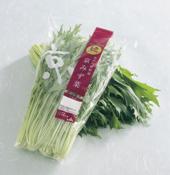
- Feather shaped leaves
- A flavor that disguises the smell of meat
- Fresh, crisp taste and mild flavor
- Rich in vitamin E
- Used as an ingredient for simmered dishes with deep fried bean curd, salad, marinated food with mustard, and pickles
Mibuna greens
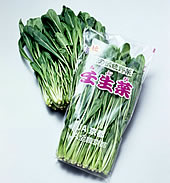
- Natural hybrid of Mizuna greens
- Spatula shaped leaves
- Mustard flavor
- Rich in vitamin C and dietary fiber
- Tender flavor, good for marinated food, fried food, and pickles
Kujonegi green onion
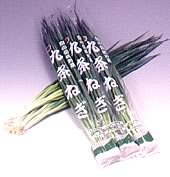
- Slickness in the leaves gives it a sweet flavor and tender texture.
- Rich in carotene and vitamin B
- Good condiment with its rich aroma
- Can be used as an ingredient for simmered dishes and marinated dishes with deep fried bean curd, squid and vinegar miso dressing
Kyo-Yasai brand (Spring-summer produce)
Kyo-takenoko bamboo shoots
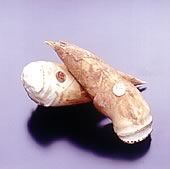
- From late March to early May
- Spring delicacy with about 300 years of history
- No acrid flavor, and fleshy and tender
- Rich in protein, sugar content and dietary fiber
- Used as an ingredient for kinomeae marinated food, simmered food, tempera and sashimi
Fushimi-togarashi green peppers
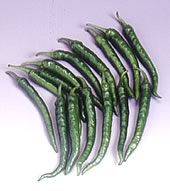
- From late April to late October
- The peppers, which used to be grown mostly in the Fushimi area, are currently
cultivated throughout the prefecture. - No pungent flavor
- Rich in calcium and dietary fiber
- Can be used as an ingredient for grilled, simmered and tempura foods
Manganji green peppers
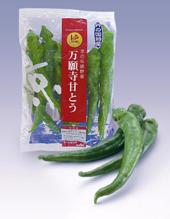
- From mid May to late October
- Large type of pepper grown in the Maizuru region
- Fleshy, sweet and tender
- Rich in vitamin C and dietary fiber
- Has few seeds and can used as an ingredient for grilled, simmered and fried foods
Kamo-nasu eggplant
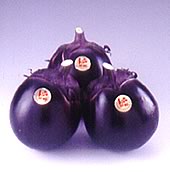
- From late April to late September
- Large eggplant with a weight of 250g to 300g
- Fine in texture and never gets mushy while cooking
- Rich in vitamin C
- Used as an ingredient for the round eggplant dengaku dish
- Crunchy texture, and can be used as an ingredient for fried food
Kyo-yamashina-nasu eggplant
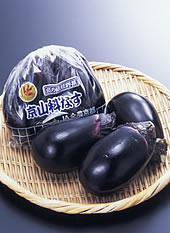
- From early June to late September
- Round eggplant with a large egg shape
- Very tender in texture, but crunchy
- Good flavor and rich in minerals such as potassium and phosphorus
- Best for simmered, grilled and pickled foods
Shishigadani-kabocha pumpkin
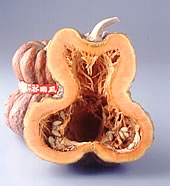
- From early July to mid-August
- Gourd shaped
- Mild flavor and fine and starchy in texture
- Never gets mushy while cooking
- Rich in vitamin C
- Try recipes that take advantage of the pumpkin’s unique shape, like stuffing it with ground meat
Kyo-kokabu turnip
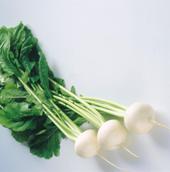
- From early May to late July, and mid-September to mid-December
- Small turnips, with bright white skin and a beautiful shape
- Finely textured, with a delicate sweetness
- Essential to Kyoto cuisine, particularly in Kyoto pickles and steamed turnip dishes
- You can also use it in a simple salad, or eat the leaves.
Kyo-Yasai brand (Autumn-winter produce)
Kyotango Nashi pear
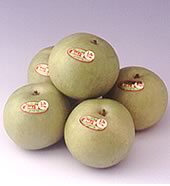
- From early September to late September
- “Gold Nijisseiki” pears are grown at the scenic Tango Peninsula surrounded by the sea
- Good quality. Pear is checked by optical sensor to confirm high quality and sugar content.
- Sweet and juicy
- Great to bring for an autumn event
Murasaki-zukin (purple hood) beans
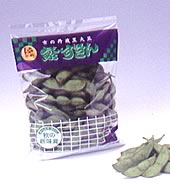
- From mid-September to late October
- Autumn edamame (green soybeans) grown from Tamba Kurodaizu (black soybeans)
- Big beans with a rich sweet taste
- Named after the purple color of its thin skin which looks like a hood
- Rich in protein, vitamin C and calcium
Kyo-kokabu turnip
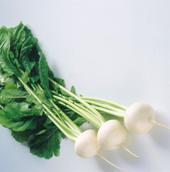
- From early May to late July, and mid-September to mid-December
- Small turnips, with bright white skin and a beautiful shape
- Finely textured, with a delicate sweetness
- Essential to Kyoto cuisine, particularly in Kyoto pickles and steamed turnip dishes
- You can also use it in a simple salad, or eat the leaves.
Shogoin-kabu turnip
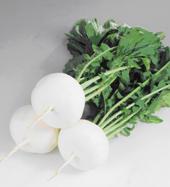
- From late October to early March
- Farmers in Shogoin first produced it from Ohmi-kabu turnips around 280 years ago
- A large, spherical and substantial turnip
- Finely textured and crisp
- Rich in Vitamin C
- Used in Senmai-zuke Kyoto pickles
- Has a wide variety of uses, from steamed in turnip dishes to raw in salads
Shogoin Daikon radish
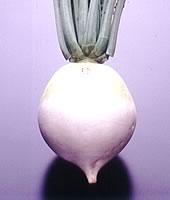
- From late October to late February
- A farmer in the Shogoin area fisrt produced this radish from Nagadaikon (long radish) in the Owari province about 160 years ago.
- Mildly sweet without bitterness
- Firmness is maintained even after cooking for a long time
- Rich in vitamin C
- Commonly used in Furofuki-daikon and Oden dishes
Kuwai bulb
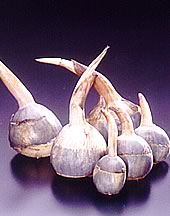
- December
- This large sprout is a symbol of growth and development, which is why Kuwai is essential for Osechi (Japanese New Year dishes)
- Sweet and bittersweet. After peeling the skin, boil with water used to wash rice or vinegar water to remove the scum.
- Best for simmered dishes, deep-fried dishes and Japanese nabe (hot-pot dish).
Hana-na greens
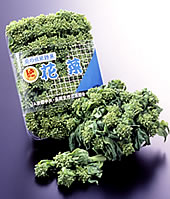
- From early January to early April
- An edible rapeseed bud, orriginally grown in Fushimi Momoyama area for decoration.
- Crunchy texture and unique flavor
- Rich in vitamin C
- Good dressed with mustard, cooked in soup, boiled, or pickled
Ebiimo potato
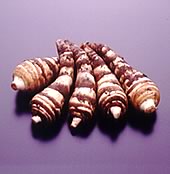
- From late October to late January
- A kind of Satoimo potato with a shape similar to ebi (shrimp).
- Firmness is maintained even after boiling for a long time, so it absorbs flavor well
- Rich in vitamin C and E.
- A popular Japanese dish is made by simmering Ebiimo with dried cod.
Kintoki Ninjin carrot
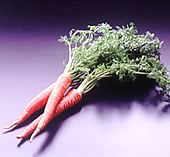
- From early November to late January
- Its skin and the fresh are bright red
- Dense flesh and sweet flavor
- Rich in vitamin A, B and C, as well as in fiber
- Because of its vivid color, it is essential for winter dishes such as Kasujiru and Nishime for the New Year. Small ones are delicious when dressed with miso or other sauces.
Horikawa Gobo burdock root
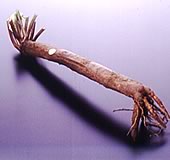
- From early November to late December
- Biennial, thick burdock
- Fresh scent and soft texture which absorbs flavor well
- Rich in vitamin C and minerals
- Meat or shrimp can be stuffed into it for a simmered dish. Before cooking, it should be immersed in cold water to remove the scum.
Yamanoimo yam
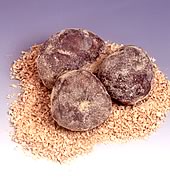
- From mid-November to late December
- Round yam, called tsukuneimo
- Starchy and rich in vitamin C
- Known for firm texture, low water content, and stickness
- Served grated in tororojiru broth
- Used as an ingredient for sweets
Tanba Kuri chestnuts
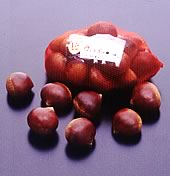
- From mid-September to late October
- Most famous chestnuts in Japan
- Large size and beautiful color
- Rich in vitamin B
- Suitable to make sweets such as Kanro-ni (boiled sweet chestnuts) or Marron Glace. Can also be cooked with rice or just boiled to enjoy its nice flavor.
Azuki beans (Kyoto Dainagon)
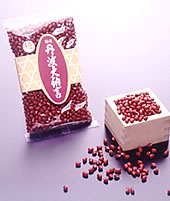
- From early December to late February
- Large size, beautiful color and fresh scent
- Best beans for making Tsubuan (mashed sweet red beans)
- Essential to making high quality sweets including Kyoto sweets.
Kurodaizu (new Tanba black soybeans)
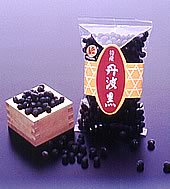
- From late December to late February
- Large size, firmness that remains when cooked
- Rich in calcium and vitamin B
- Its beautiful appearance makes it essential for Osechi. Also used in Japanese sweets or cooked with rice.
Marine Product Brand
Tango Torigai clams
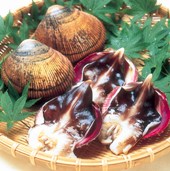
- From late May to late July
- Use techniques unique to Kyoto Prefecture: they are carefully raised for a year from young shells using rafts floating on the ocean
- They are notably larger than most Torigai clams
- Meaty and soft, with a unique sweet flavor
- In addition to being blanched or used with vinegar, they are also delicious when roasted lightly.
Processed Goods Brand
Shogoin-kabu turnip soup
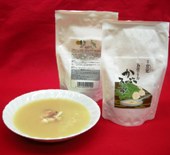
- Product name: Asagiri-ga Hagukunda Kabu Soup
- Ingredients: (Kyoto Brand) Shogoin-kabu turnips raised in the city of Kameoka, bacon, consommé, etc. (may contain milk, wheat, beef, soybeans, and chicken)
- Stored chilled, vacuum sealed (low-temperature pasteurized)
- Amount: 250g/package